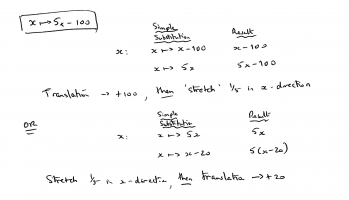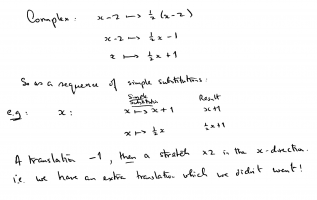What you have said is correct.
We know the effect on the graph when we make the following
simple substitutions:
[MATH]\hspace20ex x \mapsto x+k \hspace2ex[/MATH] (translation -k in x-direction)
[MATH]\hspace20ex x \mapsto ax \hspace2ex[/MATH] ('stretch' by [MATH]\tfrac{1}{a}[/MATH] in x-direction)
If we want to know what effect a complex transformation will have on a graph, we should carry out the complex transformation by a sequence of these
simple substitutions, which we know how to interpret.
E.g. starting with the graph of [MATH]f(x)[/MATH], we want to know what the graph of [MATH]f(5x-100)[/MATH] looks like. We carry out the complex transformation [MATH]x \mapsto 5x-100[/MATH] by a sequence of the simple substitutions: [MATH]\hspace3ex [/MATH]
x is replaced by [MATH](x+k)[/MATH][MATH]\hspace45ex[/MATH] and
x is replaced by [MATH]ax[/MATH]

In your next example, you are starting with the function [MATH]f(x-2)[/MATH] and you would like to know what function will have the same graph stretched [MATH]\times2[/MATH] in the [MATH]x[/MATH]-direction.
We know the simple substitution [MATH]x \mapsto \tfrac{1}{2}x[/MATH] will produce a function which has this graph.
So the function will be [MATH]f \left(\tfrac{1}{2}x-2\right)[/MATH]

What would the graph of [MATH]f \left(\tfrac{1}{2}(x-2)\right)[/MATH] look like, compared to the graph of [MATH]f(x-2)[/MATH]?
Consider the complex transformation as a sequence of the simple substitutions:



